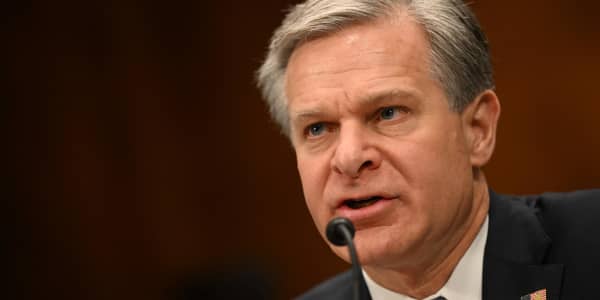Giving new meaning to 'Failing forward'
While no company is perfect, some have made missteps that hindsight makes harder to fathom: Mind-boggling products dreamed up by the brightest market research gurus—before becoming epic flops. CEOs who have the uncanny ability to say the wrong thing—when everyone is listening. Insensitivity to social norms and customs.
Some fail as a result. Some recover. And some are still struggling, years down the road. While the blunders run the gamut from catastrophic to PR gaffes that are really footnotes in a larger corporate history, they're all invaluable teaching tools. You could say the blunders give new meaning to the management mantra, "Fail forward."
Here are 12 classic corporate blunders, from the most recent to the timeless, and the lessons learned (hopefully) as a result of them.
—By Chris Morris, special to CNBC.com
Posted 03 April 2015
Sony hacks
When the "Guardians of Peace" hacked into Sony Pictures in November 2014 and demanded the cancellation of "The Interview," Sony was in a semi-sympathetic position from a public point of view. But then hackers began leaking sensitive emails, where executives mocked talent and made insensitive comments, and Sony eventually appeared to buckle to the threats, canceling the movie's release (citing theater owner concerns), then reversing that decision amidst even wider criticism, including from President Obama. It wasn't long before it went from victim to stooge.
Lessons learned: Be careful what you put in an email. In today's hack-intense society, what you say can always come back to bite you, a lesson learned by Amy Pascal, who was forced to step down as co-chairman of Sony Pictures after her emails were made public. Also, have a backup for critical systems in place. Employees had no access to email for days following the incident. Have a go-to disaster plan for a variety of scenarios, even unlikely ones, so you don't appear to flounder should disaster hit. And please check your network's security regularly.
Toys 'R' Us
In October 2014 the giant toy retailer was forced to pull from its shelves four collectible dolls based on the characters from the AMC hit show "Breaking Bad," which centers around Walter White, a high school chemistry teacher turned crystal meth dealer, who goes into business with a former student. Each of the dolls had a detachable sack of cash and a bag of meth.
This sudden scramble came after a shocked Florida mom named Susan Schrivjer saw the dolls and within days launched a petition on change.org against Toys 'R' Us. The petition yielded 9,000 signatures supporting her argument that "a show celebrating the drug trade … [is] unsuitable to be sold alongside Barbie dolls and Disney characters."
Bryan Cranston, who plays Walter White on the show, responded to the controversy, tweeting, "I'm so mad. I am burning my Florida mom action figure in protest."
Lesson learned: When evaluating which products go on store shelves, family-friendly stores need to remember their audience—and their mission statement, especially when it states that they carry "the broadest selection of products to help kids and babies develop, learn, and be safe."
Lululemon
Everyone sticks their foot in their mouth from time to time, but few have done so as prominently as Chip Wilson, founder of the yoga apparel company Lululemon. On Bloomberg television in 2013, he addressed a recall of the company's signature yoga pants, which were too sheer, saying, "Frankly, some women's bodies just don't actually work for [the pants] … It's about the rubbing through the thighs and how much pressure is there." That set off a firestorm of controversy, and his seemingly half-hearted apology on the company's Facebook page did nothing to assuage outraged customers. He eventually stepped down as chairman of the company's board. Sales have since rebounded.
Lesson learned: Think before you speak, especially in public. And if you screw up, offer a sincere, heartfelt apology, but be sure to bounce it off someone before you issue it publicly to see if it hits the mark.
Apple Maps
The increased tensions between Apple and Google in 2012 led Apple to replace Google Maps as the default mapping application on its iOS products with one of its own. The problem: Apple's mapping system wasn't nearly as good. Locations were mislabeled. Some roads weren't shown. And it occasionally steered people in the entirely wrong direction. The problem was eventually largely resolved, but it was an embarrassing misstep for a company known for never launching a product before it's perfect.
Lesson learned: Never release a product that's half-baked, no matter how desperately you want to get it to market.
JCPenney
In theory, it sounded like a good plan. Offer rock-bottom prices year-round, and don't make customers jump through hoops for a discount. But when Ron Johnson, who had made the Apple Store a corporate model of success, took over JC Penney and implemented the plan in early 2012, people didn't react like he thought they would. In-store sales fell nearly 19 percent, while Internet sales dipped just under 28 percent. Consumers, the company discovered, didn't feel a sense of urgency to shop at the store since they didn't get the rush they used to from a perceived savings over the regular price by using coupons.
Lesson learned: Some habits are so deeply ingrained that you won't be able to change people's habits, even if the alternative you offer is actually a better deal. Rather than demanding your customers change their ways, a struggling company needs to pivot instead. It's condescending for it to think it can 're-educate' customers who can simply go elsewhere.
Netflix Qwikster
As streaming video became the chief focus of Netflix, CEO Reed Hastings became less enamored of the DVD delivery service that built the company. In September 2011, the company announced it was spinning off that DVD service into a completely separate business called Qwikster—one that would use a different website and would require users to pay two different companies and maintain two separate profiles. Some 27,000 people commented on the blog post announcing the decision, calling it the worst decision since New Coke (with many calling for his resignation). It increased ill will toward the company that was already suffering from a PR debacle after discontinuing its $9.99 monthly subscription plan for both DVD and streaming movie rentals. Within a month, Qwikster was killed.
Lesson learned: Never make things more complicated for your customers. It wasn't the name Qwikster or the fact it was being treated as a separate company that people minded, it was the huge inconvenience that went with it. A company should speak with a single voice.
Bank of America debt-card fee
The backlash against the banking industry didn't start with the financial crisis. It started in 2011, when Bank of America announced it would charge customers $5 per month to use their debit cards for purchases. It was an ill-timed move, especially as the Occupy Wall Street protests had begun to gain steam. More than 300,000 signed an online petition. Fox Business Network's Gerri Willis cut up her debit card on air. Bank of America pointed to federal regulations as the reason for the charge initially, but ultimately capitulated to consumer demand after a month, and before the fees went into effect.
Lesson learned: The real regulator of the banking world isn't the government, it's the market. Even when there's a legitimate reason to raise fees, doing so without a solid, easy-to-understand explanation—and doing it in a way that directly impacts the pocketbooks of people—is a recipe for disaster. It's perhaps better to spread out those fees in a variety of less obvious ways.
Kodak
Kodak used to be the photo industry's king of the hill, creating the first mass-market and instant cameras. But when digital photography came along, the company failed to move quickly. The great irony was that it was a Kodak engineer who invented the first digital camera. In 1975, Steve Sasson took his invention to company management, who didn't see the disruptive potential of the technology and told him to shelve the project. And even as digital photography began to take off several years later, Kodak ignored it. By 2012, the company had filed for Chapter 11 bankruptcy protection. It's still around today, with a focus on monetizing its many patents, and hit its 2014 goals, but today's Kodak is a mere shadow of what it was at its prime.
Lesson learned: When a transformation is happening, it's important to pivot appropriately. Sticking to an old, dying model for too long, even one you helped pioneer, can be fatal for your business.
Blockbuster and Netflix
In the early 2000s, before Netflix was an industry leader, Reed Hastings had several discussions with Blockbuster CEO John Antioco to see if the video chain would be interested in purchasing its DVD-by-mail company for $50 million. Antioco passed, thinking there would never be a substantial market for such a model and said the asking price was much too high. Today, Netflix has a market cap of $25 billion and Blockbuster is nothing but a memory.
Lesson learned: It's critical to take a long-term view of your industry. Be open to possible changes, even unpleasant ones, so that you can plan for them.
AOL/Time Warner
The biggest bombshell of the dot-com days came on Jan. 10, 2000, when AOL and Time Warner announced a $160 billion merger. Heralded by some as the convergence of old and new media, it gave the parent company of Time, People, HBO and CNN new ways to reach people, while AOL got access to Time Warner's content library and speedy Internet backbone. Many insiders at both companies, though, were opposed to the deal. And the culture clash between the two was beyond what anyone could imagine. As a result, the proposed integration never really happened. When the dot-com bubble burst, it wiped out more than $100 billion in shareholder value between the two companies.
Lesson learned: Merger partners have to make more than economic sense. Make sure the cultures mesh as well, and clearly dictate the chain of command. If the two companies can't work together, the deal is bound to end in failure.
Wow Chips
Frito-Lay, hoping to hop on the fitness bandwagon in the late 1990s, introduced a new variety of its Lay's, Ruffles, Doritos and Tostitos brands that were entirely fat-free. Things went well at first, but then reports began surfacing that the fat substitute, Olestra, was causing "anal leakage" in some customers. That led to a warning on the bags, and the reputational damage was done.
Lesson learned: Never put your flagship products in a position where they can be weakened. The Olestra ordeal didn't cause long-term damage to Frito-Lay, but it did make it the long-running butt of plenty of jokes (like that one).
New Coke
Taking big risks with venerable brands can result in big rewards, but sometimes they can almost sink your company. In 1985, The Coca-Cola Company announced it was changing the formula of its flagship soda in an attempt to reenergize the brand and fend off an increasing challenge from Pepsi. It set off a consumer backlash that was unprecedented. More than 400,000 calls and letters flooded the company headquarters. Comedians and columnists mocked the decision. Even the father of then-CEO Roberto Goizueta reportedly wasn't a fan of the decision. A few months later Coke bowed to the pressure, introducing Coke Classic, with the drink's original formula.
Lesson learned: Coke had focus group information showing people preferred the new taste, but the company failed to take into account the bond consumers had with the brand. And that was something they didn't want anyone to tamper with. If you've got a product people connect with, there are better ways to improve your market share than upending it, no matter what the focus groups say.





